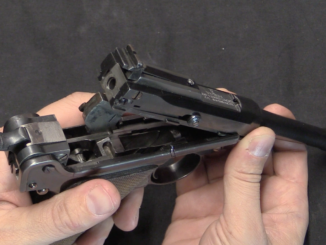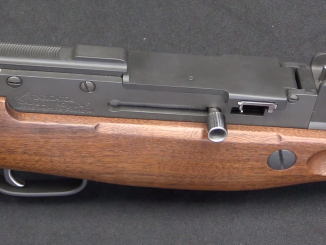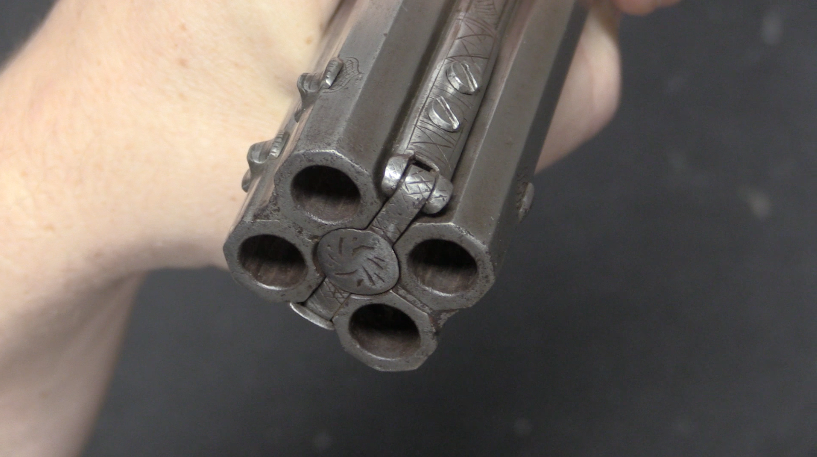While the Model 1873 was a very popular rifle, its pistol caliber cartridge did leave a segment of the market unaddressed. Winchester wanted a rifle that could chamber the larger and more powerful cartridges popular with long range hunters, and the Model 1876 would be that rifle.
Early attempts to enlarge the 1873 action to use the .45-70 Government cartridge were unsuccessful, for two reasons. First, the cartridge in its 45-70-500 infantry configuration was simply too powerful for the toggle lock design that had been the core of all Winchester’s rifles back to the 1860 Henry. In addition, the elevator mechanism used to feed the rifle had to be sized to a specific (and fairly precise) overall cartridge length. The variety of different bullet weights used in the .45-70 did not affect use in single shot weapons, but did cause problems for Winchester’s repeater.
The solution was for Winchester to design a new round for it’s scaled-up Model 1876. This was the .45-75, and it used a relatively light bullet and a bottlenecked case similar to the general design of the .44 WCF from the Model 1873. This bottleneck improved obturation, preventing powder fouling from leaking around the cartridge case and into the working parts of the rifle. This was not strictly necessary though, as new chambering of the 1876 would be quickly added, including the .45-60; a straight-wall shortened version of the .45-70 Government round.
While it did not blow the doors off the factory like the 1873 had, the Model 1876 was a popular rifle with its intended audience, with tens of thousands of rifles sold to men including Theodore Roosevelt.




If I am not mistaken, all 76 carbines were fitted with musket style forearm. They were the only Winchester carbine with such furniture.
A little precision on 76’s cartridges: the 50-95 was a necked up 45-75. Necking up the 45-70 to 50 call will give you a reversed taper case…
“50-95”
Dimensions of this cartridge: http://www.municion.org/Win/50-95Win.htm
The North-West Mounted Police were established in 1873 as a paramilitary police force to police the territories which Canada had just acquired from the Hudson’s Bay Company (the Canadian equivalent to the East India Company). These were known and the North-West Territories, hence the name NWMP. The Mounties operated over a vast area, and in the early days a very remote and isolated one.
The NWMP armoury included such things as machine guns and light artillery, so this rifle was expected to fit in with that sort of context. The NWMP were the reason there was no “wild west” in Canada such as existed in the US. They also kept a very tight lid on the Klondike gold rush. The one major exception to this was the North West Rebellion of 1885.
The NWMP became the Royal Canadian Mounted Police (RCMP) when they were merged with the Dominion Police in 1920. The Dominion Police had several tasks, but the main one was was security intelligence and anti-terrorism. They were founded in 1868 to deal with terrorists and insurgents operating against Canada from bases in the eastern US. The security intelligence functions were split off from the RCMP again some time in the 1970s or 1980s, or somewhere around there.
Today, the RCMP act as the provincial police for most provinces and territories across Canada except for Ontario, Quebec, and Newfoundland.
Given the context in which it was used, that rifle Ian looked at will likely have a rather interesting historical background to it which goes well beyond it just being an example of a model of old rifle.
“.45-60; a straight-wall shortened version of the .45-70 Government round.”
Basing on data from municion: http://www.municion.org/45_60/45_60Win.htm
it seems to have bit bigger rim diameter (15,91 mm vs 15,17 mm)
CIP gives both the .45-75 & .45-60 a rim diameter of 15.98mm. The latter is very slightly tapered according to them. .45-70 Government has a rim diameter of 15.44mm in CIP specs. All specs are here under the TDCC column as pdf files:
http://www.cip-bobp.org/homologation/en/tdcc_public?page=6&cartridge_type_id=2
The 45-60 rim is also thinner: 1,64 mm instead of 1,78 mm for the 45-70. And trust me, that makes a difference.
45-60 cases are easy to make from 45-70 ones but depending on the cases brand you might need to thin the rims. Otherwise you will get a hard time to close the 76 action!
I was lucky with my Uberti 76 replica but a friend of mine had to thin all his cases for his.
This is probably the farthest one could go with black-powder munitions… 10 years later, smokeless powder ammunition would take center stage along with the Lebel rifle. This would then usher in the era of small caliber projectiles launched at much higher muzzle velocities. But I have to ask: was the Winchester Model 1876 using rounds meant for long range penetration or after-effects upon impact with the intended victim? Given that it was using large caliber rounds, I suspect the latter… or am I wrong?
“large caliber”
It might be considered large from modern point-of-view, but back then I would say it would be normal or average
“farthest one could go with black-powder munitions”
Depend what you are looking for, due to its nature black-powder has limitation in maximal muzzle velocity, but there existed heavier (bigger momentum) black-powder cartridges like .500 Black Powder Express
I was surprised to find that 4 Bore cartridge is actually standardized by CIP:
http://www.cip-bobp.org/homologation/uploads/tdcc/tab-ii/tabiical-en-page132.pdf
Via the US, no less, alhough the historical origin of this cartridge is the UK.
“farthest one could go with black-powder munitions”
I can’t agree, there was black-powder 9.5 Turkish Mauser: http://sportsmansvintagepress.com/read-free/mauser-rifles-pistols-table-of-contents/95mm-turkish-mauser-model-87/
Also, note that .303 British: https://en.wikipedia.org/wiki/.303_British
was black-powder when initially introduced.
“farthest one could go with black-powder munitions”
In accuracy area, В.Е. Маркевич (“Ручное огнестрельное оружие”) cite data from «Shooting and Fishing» with data obtained in 1880s, which divide cartridges in 4 classes:
1st class (almost all hits in 6″ circle @ 200 yards):
32-40-125, 32-40-150, 32-40-165, 38-55-255, 40-83-390
2nd class (8″ circle, 200 yards):
22-10-45, 22-15-45, 25-20-77, 25-32-67, 25-32-76, 32-20-115, 32-30-125, 40-62-210, 40-82-260, 44-40-200, 45-60-300, 45-75-350, 45-70-405, 45-90-300, 40-90-300, 45-109-550
3rd class (12″ circle, 200 yards):
38-90-250, 40-75-230, 45-85-290, 45-125-300
4th class (20″ circle, 200 yards):
50-110-300, 50-115-300
On same page, there is table – it shows, that flattest shooting was .25″ caliber with 32 gr. black-powder and 67 gr. bullet.
“the farthest one could go with black-powder munitions” – No, this was as far as Winchester could go, at the time, with the Henry lever-action design. When scaled up to .45-70, (which was done, see experimental receivers at the Cody Firearms Museum), the parts would warp and distort.
“But I have to ask: was the Winchester Model 1876 using rounds meant for long range penetration or after-effects upon impact with the intended victim?” – Answer: Both. Before the advent of reliable expanding bullets, sectional density was all you had to work with to effectively put down game.
Youtuber Madras Arsenal has video shooting black powder 7.62x54R in a Mosin 91/30. He tells that black powder loads were actually used by the Russians when lacking proper nitro powder.
It should be mentioned that one of the mechanical changes made between the Henry/1866 and the 1873/1876 is the interlock between the lever and the trigger. There is a small plunger just behind the trigger that is compressed by a tang on the lever at the front of the finger loop that operates a trigger block that prevents the trigger from releasing before the lever is fully against the wrist of the stock.
It’s there to prevent hammer follow-down, and possible discharge of the gun before the toggle is fully locked (not a good thing). Unfortunately, this device is easy to break and is often found broken, disabled by corrosion and fouling, or simply missing. When not fitted properly it can be an annoyance, and was often removed to make the guns run more quickly.
What sort of bayonet was meant to be used on the Winchester musket style rifles? Was there a proprietary Winchester bayonet, or was the idea that you could use any socket style bayonet that would fit over the barrel and lock over the front sight? Was there a bayonet adapter made for musket length rifle with Octagon barrels?
Kento,
Best source on the web for bayonet info:
http://worldbayonets.com/Bayonet_Identification_Guide/United_States__19th_Century_/us_19th_century_2.html
Hope that helps.
There is no bayonet listed for the Winchester M1876, so I suppose it used the same bayonet as the M1873, which in turn was broadly similar to the US Army bayonet for the Springfield M1873 rifle.
Thanks for all the information.